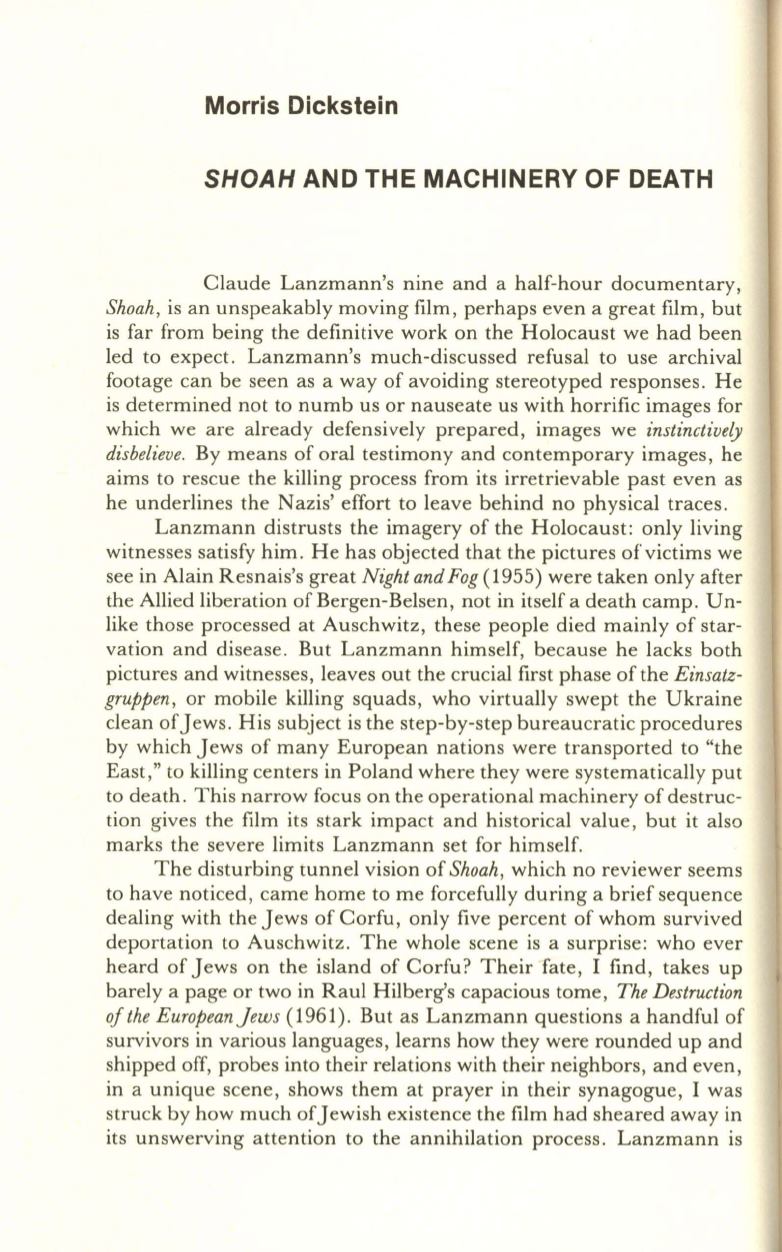
Morris Dickstein
SHOAH
AND THE MACHINERY OF DEATH
Claude Lanzmann's nine and a half-hour documentary,
Shoah,
is an unspeakably moving film, perhaps even a great film, but
is far from being the definitive work on the Holocaust we had been
led to expect. Lanzmann's much-discussed refusal to use archival
footage can be seen as a way of avoiding stereotyped responses. He
is determined not to numb us or nauseate us with horrific images for
which we are already defensively prepared, images we
instinctively
disbelieve.
By means of oral testimony and contemporary images, he
aims to rescue the killing process from its irretrievable past even as
he underlines the Nazis' effort to leave behind no physical traces.
Lanzmann distrusts the imagery of the Holocaust: only living
witnesses satisfy him. He has objected that the pictures of victims we
see in Alain Resnais's great
Night and Fog
(1955) were taken only after
the Allied liberation of Bergen-Belsen, not in itself a death camp. U n–
like those processed at Auschwitz, these people died mainly of star–
vation and disease. But Lanzmann himself, because he lacks both
pictures and witnesses, leaves out the crucial first phase of the
Einsatz–
gruppen,
or mobile killing squads, who virtually swept the Ukraine
clean ofJews . His subject is the step-by-step bureaucratic procedures
by which Jews of many European nations were transported to "the
East," to killing centers in Poland where they were systematically put
to death. This narrow focus on the operational machinery of destruc–
tion gives the film its stark impact and historical value, but it also
marks the severe limits Lanzmann set for himself.
The disturbing tunnel vision of
Shoah,
which no reviewer seems
to have noticed, came home to me forcefully during a brief sequence
dealing with the Jews of Corfu, only five percent of whom survived
deportation to Auschwitz. The whole scene is a surprise: who ever
heard of Jews on the island of Corfu? Their fate, I find, takes up
barely a page or two in Raul Hilberg's capacious tome,
The Destruction
of the European Jews
(1961). But as Lanzmann questions a handful of
survivors in various languages, learns how they were rounded up and
shipped off, probes into their relations with their neighbors, and even,
in a unique scene, shows them at prayer in their synagogue, I was
struck by how much ofJewish existence the film had sheared away in
its unswerving attention to the annihilation process. Lanzmann is


